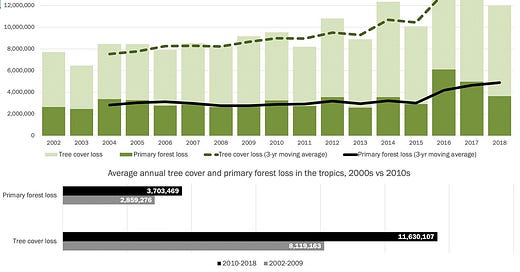Terrestrial Biomass Sinking
Trees suck up the carbon in the atmosphere when they photosynthesize. They are one of the world’s biggest carbon sink. Clearing forests, natural or otherwise releases this carbon back into the atmosphere, nullifying the hard work done by the trees over decades.
Forests are disappearing at an alarming rate. They are cleared for agriculture expansion, urbanization, cattle ranching and a multitude of other reasons. Natural and Climate change induced wildfires are adding to the increasing woes.
The logged trees are left to decompose making them emitters instead of absorbers in their final act. Forest harvests between 2010-2050 will have a carbon cost of 3.5-4.2 Gt CO2/ year.1 This creates an urgency to find solutions that can safely sequester carbon from the lost biomass. The bigger sibling of the carbon sinks, the oceans, can come to our aid.
Oceans are the world’s biggest carbon sink storing about forty times carbon in the atmosphere. The oceans already stores 135 Trillion tons of CO2 and can store many more.2 Decomposition of the biomass can be avoided by sinking wood into the oceans at or below certain depth due to low oxygen, cold temperature and high pressure. Trees sunk below 1000 meters won’t come into contact with the atmosphere for a thousand years, thereby permanently sequestering carbon.3
Several companies such as, Carboniferous, Rewind and Running Tide are conducting research to safely sink waste biomass underwater. Marine CDR is an emerging field and a lot remains unknown. Regulations are holding back the progress in the field and the governments have been circumspect in issuing permits. There are concerns cited over the durability of the method and effects on the ocean ecosystem. Frontier in its’ most recent offtake RFP isn’t accepting applications for biomass sinking.
While it is important to conduct due diligence about the outstanding effects of biomass sinking, rapid scale up of nature based sequestration solutions is essential to reach net zero goals. The answer is to go faster and not slower.
Peng, L., Searchinger, T.D., Zionts, J. et al. The carbon costs of global wood harvests.Nature 620, 110–115 (2023). https://doi.org/10.1038/s41586-023-06187-1
Suarez,C.A ,Edmonds, M.,Jones, A. P.; Earth Catastrophes and their Impact on the Carbon Cycle. Elements 2019; 15 (5): 301–306. doi: https://doi.org/10.2138/gselements.15.5.301
Boyd, P.W., Claustre, H., Levy, M. et al. Multi-faceted particle pumps drive carbon sequestration in the ocean. Nature 568, 327–335 (2019) https://doi.org/10.1038/s41586-019-1098-2




